Is the City of Portland, newly anointed “Biketown”, really going to remove a bike lane because our state department of transportation said it would improve safety?
That story we reported yesterday has sparked outrage, confusion, and frustration — all completely reasonable reactions to the idea of removing a bike lane in order to make biking safer. While we work to clarify the details and get to the bottom of what’s really going on (weaving the different communications from city officials and state officials together into one coherent whole is proving more complicated than expected), I thought I’d share what two notable Portland bike advocates think about the idea.
“If we have a safety problem, why would you take the victims of that problem and force them to go to a different place?”
— Ray Thomas, lawyer and veteran bike advocate
I called lawyer Ray Thomas yesterday to ask him about the legal implications that might arise if the bike lanes were removed and someone riding a bike was subsequently hit and injured or killed. A lawsuit that settled in California just a few months ago ordered the City of Indian Wells to pay $5.8 million to a man’s family after he was killed while biking on a street where bike lanes were removed.
When it comes to the possibility of removing the bike lanes on SE 26th Avenue, Thomas said he was more curious about the political liabilities of the decision. Here are his comments:
“If we have a safety problem, why would you take the victims of that problem and force them to go to a different place? Why would you take an existing facility out on a corridor where people ride and force them into what is essentially a detour? It’s sort of like adding insult to injury. You’re punishing the victim. I’d rather see them spend money to improve the intersection or restrict traffic on 26th so it could be a pedestrian and bicycle non-motorized corridor.
This is a solution that doesn’t take into account the nature of the wrong, which is, that people are driving dangerously. A solution that sends the bicyclists on a detour, even with a nice signal, doesn’t make sense to me.
If someone was hit trying to follow the bike map on 26th that shows it as a bike route, or trying to follow the new the detour, then I could see it resulting in some liability; but mostly I see it as just a bad idea.”
Advertisement
The next person I talked to was the Executive Director of the Bicycle Transportation Alliance, Rob Sadowsky. He said he and staffer Gerik Kransky met with ODOT Region 1 Director Rian Windsheimer and ODOT’s Region 1 Public Policy and Community Affairs Manager Shelli Romero several months ago when the issue first bubbled up with a big rally at the site back in May. Sadowsky expressed some confusion about the removal of the bike lane because he has heard different things from ODOT and the Portland Bureau of Transportation (PBOT). “I’m hearing different things from different people at both agencies,” he said.
“Over our dead bodies. I made that clear. We will look at legal options if necessary.”
— Rob Sadowsky, BTA
At issue (and we’ll be reported more on this later today) is the timeline. If ODOT got an agreement from PBOT to take out the 26th Avenue bike lane in exchange for putting in a signal across Powell at 28th, when would the bike lane on 26th get removed? Sadowsky said he’s asked PBOT to keep the bike lane as long as possible, well after any construction on the signal.
In general, Sadowsky said, “This is a really clear example of how ODOT’s priorities are very different than local prioriries. It’s the same battle we’re having on Barbur.”
So, what does the BTA plan to do if the bike lane gets ripped out? Sadowsky didn’t mince words:
“We went to ODOT, and we said, ‘Over our dead bodies.’ I made that clear. We will look at legal options if necessary.
We’re not going to let this bike lane go away. We believe very strongly that you need arterial and neighborhood greenway treatments at the same time. And they picked the wrong street. Our Board Member Leslie Carlson has kids at (adjacent) Cleveland High and my stepdaughter goes to Cleveland. We will look at every option we have including legal options. We also want to partner with PBOT and ODOT and use this as a case study to do more planning as a group. We see this as a sympton of other challenges around the way DOT policy and implemntaiton lines up around bicycle planning.”
Stay tuned. Michael is working on a story today that should clarify exactly where things stand with this bike lane.
UPDATE, 3:#9 pm: Here’s the latest update with clarifications from PBOT and ODOT about the future of the 26th Avenue bike lanes.
— Jonathan Maus, (503) 706-8804 – jonathan@bikeportland.org

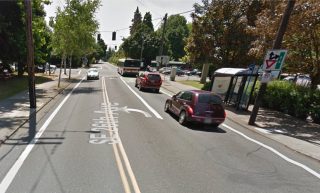
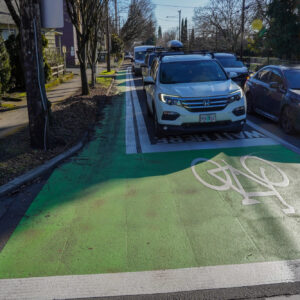
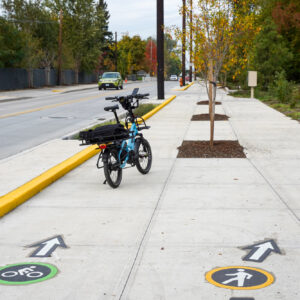
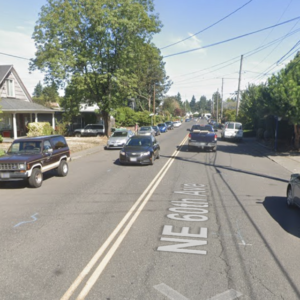
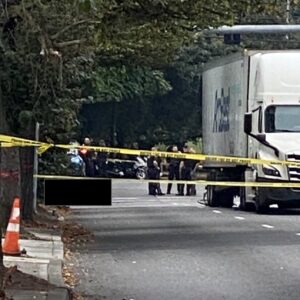
Thanks for reading.
BikePortland has served this community with independent community journalism since 2005. We rely on subscriptions from readers like you to survive. Your financial support is vital in keeping this valuable resource alive and well.
Please subscribe today to strengthen and expand our work.
26th is easily the worst bike facility in the city. It’s under a mile long, less than four feet wide, doesn’t have any buffers, nor does it connect to anything.
Perhaps PBOT just agreed to remove it, but will keep it anyway since bike volumes are not likely to drop after the facility on 28th is installed. Then they can use it as an excuse to upgrade it to a protected bike lane.
it’s only .6 miles, from Taggart to Gladstone…
but it’s the only through street between 17th and 42nd with any sort of bicycle facilities… the other bikey streets dead end a few blocks south of Powell or at Division…
I tend to make my Powell crossings at 21st (no bike facilities, but generally ok as long as you watch out for left-turners coming the other way) or 33rd (has lights with bike facilities). This isn’t much help to anyone needing to get to Cleveland HS or thereabouts though.
21st is waaaay better than 26th to ride on.
I’ve started using 21st since I discovered you can jog to 22nd at Bush, and go all the way to Gladstone.
If you’re continuing south, you can go all the way to the block before Holgate, if you are so-motivated and like riding on quiet residential streets.
It connects to the bike lanes on Gladstone and the greenway on Clinton, not to mention the commercial node at Clinton and the front door of Cleveland HS. You can also use it to access Powell Park to the west and the many homes that line the street, as well as bus lines that run along 26th and Powell. Seems well-connected to me.
It is an essential connection between Reed College and Eastmoreland to points north and downtown.
The bike lane stops before it reaches Reed though.
Are you sure?
What’s the matter, can’t you ride a bike where there isn’t a bike lane?
My personal fave heading North from Reed/Eastmoreland is through Reed across the E Canyon bridge stopping to admire the ducks (admittedly, this part doesn’t exactly shout “bicycle superhighway”, but it’s very pleasant), pop out onto SE Insley street through the carpark, then up 34th as far as Francis (Holgate crossing can be a pain) then over to 33rd Ave to cross Powell and up to Clinton, from whence the world is your Oyster.
It may not be very good, but the bike lane is *something* and it’s better than *nothing.* It’s a lot better than nothing. Incremental improvements may be all we can expect in the future, and if that’s the case, removing the lowest rungs on the ladder won’t help. Furthermore, each neighborhood needs access for bikes (just like it has for cars): losing access in one place is a loss for that street even if some access opens up later.
Depending on the quality, a bike lane is worse than nothing. We’ve very recently gone over how poorly done the Lombard bike lane is. A bike line should be a reasonable way to travel. If I take an unsafe path, it’s because I wanted to take it. It should not be because someone else though a strip of white paint the width of the drain is good enough.
I will take exception to your suggestion that ‘it doesn’t go anywhere’. 600 daily cyclists have decided for THEIR needs, it does. Despite the fact it kinda sucks for safety. Unfortunately, it crosses Powell with 6000 daily users in their cars.
This is exactly what PBOT should do. Get the signal in at 28th, and then sit on their hands. What is ODOT going to do? They don’t have the jurisdiction to re-stripe 26th themselves. PBOT can leave it as is and tell ODOT to go pound sand.
Well said Ray! and Go get them Rob!
I think that this is an ODOT strategy to get the City of Portland to take over Powell Boulevard without any commitment by ODOT to either upgrade the street or to make any payments to the city for taking it over.
The sticking point on road transfers between agencies is that the receiving agency wants control of a street but won’t accept anything that needs lots of work (costs money to upgrade or fix).
I’m so frustrated with ODOT, I’d accept the damn street from them without any funding. Admittedly it’s not a good negotiating strategy on my part to reveal that now, but thankfully, I’m not the city’s negotiator.
You should be frustrated with PBOT. They control the bike lane on 26th, not ODOT.
Yes. But ODOT is the agency that is demanding the removal of the bike lanes on 26th in exchange for permission to put a new signal at 28th. Installation of a signal on a state highway must be authorized by the state traffic engineer. If it were merely a city street, the city could do with it what they wanted.
Do you think you could get a crossing at 28th without conceding on 26th? If so, I’d hire you!
Yes stay tuned…in my past internal experience on these types of issues (as I am not involved in this case)…if two agencies are saying different things about the removal of a roadway safety feature/ active transportation facility or even phasing of the changes then there may be no real good engineering reason to do it at best … that the need or alternatives evaluation process may have been minimal or incomplete.
What would happen if the city demanded payment for the expense of removing the striping before it were to be done?
They’ll be repaving, so the expense is pretty low.
This is not coming out of nowhere.
There are planners and long-time advocates in Portland who favor removal of arterial/commercial bike lanes.
“Separate routes (such as cycletracks or paths) and low-speed routes (such as bicycle boulevards) should be prioritized over alternatives, even if it means eliminating bicycle lanes on high-speed or high-capacity streets.”
“Separated bicycle routes (cycletracks, paths, bike boulevards) should be prioritized over shared routes between bicycles and automobiles…
This may include eliminating some bicycle lanes on high-congestion streets and designing safer options that incentivize alternative bicycle routes.”
http://www.pdxcityclub.org/files/Reports/No%20Turning%20Back_%20A%20City%20Club%20Report%20on%20Bicycle%20Transportation%20in%20Portland_0.pdf
Attempts to discourage use of arterial/commercial routes by people cycling has been a recurring theme in Portland. The infamous Alberta PBOT sign and Mia Birk’s Tribune rant about people cycling on Hawthorne are just a few examples.
Both of your quotes included references to cycle tracks, and are saying that it may be worth replacing a regular bike lane with a separated/protected bike lane. This is absolutely true in many cases.
From my understanding the fiasco here on 26th has less to do with a prioritization of bicycle boulevards over on-street bike lanes, and more to do with the technical mechanism ODOT is relying on in order to meet their signal warrants.
ODOT is relying on the fact that 28th is the major bicycle route across Powell and is deserving of a signal even if that location wouldn’t meet conventional warrants for signal installation. The presence of the bike lane on 26th belies that position, which is why they request removal.
They reference bike boulevards as well and are referring to removal of facilities on parallel streets, IMO.
PS: I just noticed your comment about the cycletrack in Hillsboro earlier this year. I stand corrected — that would not be out of place in CPH.
28th Ave is in no way currently any type of bike route near Powell. All bike traffic is on 26th near Powell.
ODOT just wants bikes off of 26th so they can make the freight lobby happy.
What is the benefit of removing the bike lanes on 26th? I don’t see how this will improve the flow of traffic through the intersection at all.
That’s not their goal. Their stated goal is to ensure that there is enough cross traffic to justify installation of a signal at 28th, and if too many cyclists use 26th, they will not get the counts they feel they need. Removing the lanes from 26th is a way to get more cyclists to use 28th.
I think their unstated goal, as I’ve stated elsewhere, is to avoid having another bike “incident” at 26th that would raise more questions about safety.
Nonetheless, if cyclist counts at 28th are high enough while the bike lanes still exist on 26th, it may be possible that PBOT will be able to make the case for keeping both. We’ll have a year or two to find out.
Ironically, this means that the best way to make the case for keeping bike lanes on 26th may be to use the new crossing at 28th.
If this is the case, ODOT has declined to explain it publicly. When I started reporting this story I learned a bunch of stuff about signal warrants but ODOT staff just wanted to talk about how terrible 26th Avenue is.
People cycling on busy streets is hurting cycling in this town, not helping….
Cycling needs public support from non-cyclists, like it or not. I am tired of defending to my non cyclist friends why idiots are riding on Fremont when they could be 1 block over.
When I drive, I pay attention not to drive through quiet neighborhoods and stay on roads meant for car transportation. Cyclists can do the same.
It does not mean we need to be second class transit users, we should get certain streets to ourselves and cars likewise.
The goal of getting granny and the 6 year old on bikes for transportation will never work if the 6 year old is riding on streets with cars…..
I use NE Fremont between 47th and 52nd on a weekly basis since I live off 47th. Shout out to Jim & Pattys coffee cake and Bottles BBQ!
Just curious, am I an idiot for riding those 5 blocks or should I be crossing Fremont 4 times per round trip? What do your non-idiot non-cycling friends think of this behavior? Does one of your friends drive a champagne Dodge Durango by any chance? That guy had a conniption for my transgression except I never made it 2 blocks before his hissy fit at 8 am on a Sunday.
Congrats to you….Ride wherever you want.
Irritating drivers is fun isn’t it?
I guess Klickitat is too busy for you to ride that 5 blocks?
Irritating drivers is not fun, but you keep on asserting things about people you don’t know. I guess I have to be some caricature of a militant biker to make the decisions I do.
From a population perspective, the main thoroughfares don’t have any meaningful amounts of cyclists using them. The stream of cyclists riding to work are on Going, not Prescott. They’re on Ankeny, not Burnside. Clinton, not Division. Enjoy your crusade for 100% compliance from a group of unassociated people based on a cultural rule. I think 98-99% should be acceptable and let us 1% use a thoroughfare for the last few blocks.
You’re position is untenable if you actually want to see bike use increase because you’re perpetuating the very inconveniences that keep it from having widespread adoption.
Ride wherever you want…….
but- bike routes are always on the side streets- the streets were sort of designed to keep cars from jogging into residential neighborhoods, so bikes normally have to jog 2 blocks off commercial cooridors then back again two blocks if they want to visit a business on one. Maybe people should not bike on 39th avenue, but 26th is not a busy street like 39th. Cleveland you can drive a car 30 MPH on 26th ave, however the private catholic school on Stark slows traffic to 20 MPH. There is not even a school zone for Cleveland drivers (not that people really want to go any faster than this.
Perhaps the speed both north and south of 26th should be turned to 25MPH, and speed bumps installed. why do cars need to cut across 26th anyway that badly.
Im Surprised no one has mentioned Fred Meyers in all of this discussion- since they are major users of this cooridor- the morning traffic is a large part theirs. do they bike to work??
When cycling solo I typically take Chavez to get to the Hollywood district because the meandering legacy bike boulevard on 41st/42nd and non-bike friendly bridge are a pain to use
People using neighborhood streets as if they were collector streets are hurting drivers in this town, not helping….
Driving needs public support from non-drivers, like it or not. I am tired of defending to my non driver friends why idiots are driving on Clinton/Tillamook/Ankeney/Lincoln when they could be 1 block over.
Etc, etc…
That’s fine, but where are the separate cycle tracks? I don’t see a lot of action on this front. Which makes me worry it’s just a smokescreen for “We’re pushing cyclists off certain streets and don’t care where they go instead.”
I contacted Cleveland High and City of Portland Parks and Recreation. both are stakeholders in the planned revision. Users of both their facilities would be negatively impacted by removal of the bike path and associated work on Powell that would facilitate higher traffic speeds.
Oh, the original article and associated links lead me to think that the ODOT/PBOT cabal was making changes to 26th (a residential street) to make it a freight route
As you know from riding those streets, 26th is already a freight route serving the rail yards at Holgate, is a bus route (#10), and a return route for out-of-service buses destined for Trimet’s Center Garage.
Fred Meyer- is a major user of that street
Yes, SE 26th from Holgate to Powell is a current designated freight route by the city, but this definition of a freight route (allows local business to get access to their truck lanes) is being totally abused by the UPRR international container cargo business which has greatly expanded in the heart of SE Portland. They want to see these heavy haul, full 53′ trailers coming and going to China have unfettered access to roar down SE 26th all day and night. These cargoes have no local business are are simply being trans-loaded from one rail line to another, and don’t originate or end at local business. It is just a local truck haul link from one rail station to another and between China and Chicago. This business benefits nobody in the local area, and is lining the UPRR rail baron’s pockets, who in turn put heavy pressure on ODOT through lobbying.
City should restrict 5 axle trucks from this street, and continue to allow local freight needs for local business, but restrict use on this street to the international China cargo trans-loading activities. These UPRR freight activities need the people, bikes, children, and peds to all get out of their way so they can drive their ancient, polluting, diesel rigs through the neighborhood with impunity.
That doesn’t sound very efficient. They can’t move containers between trains in the yard? They have to load them onto trucks and then drive around the neighborhood for some reason? Can you explain this?
UPRR shifted (or is shifting) much of its container traffic from the Albina Yards to the Brooklyn Yards. I think Bald One is mistaken about where the containers are going. I think they are not being shifted around Portland, but rather being trucked further out, to various regional destinations.
I do think he is right in saying that Portland does not get much direct benefit from this activity.
There are certainly some Regional businesses who are using the Brooklyn yard to load in and out of, but why should this freight have to go down SE 26th Ave? Why should the Railroad owners get super rich hauling all this cargo on the backs of local residents? We have seen these containers all go from 20′ to 40′ to 53′ over the years with no expansion of local services to accommodate these larger loads. They should be forced to invest in an upgraded fleet of tractor trucks driven by company carriers with modern pollution control standards (CA Certified Clean Idle) instead of these ancient polluters driven by local independents. Farmers down in the valley should figure out how to get their product to foreign market by some other means than trucked down Porltand local streets.
Two bad practices from the UPRR Brooklyn yard. They have an enormous yard at Brooklyn UPRR in SE Portland, but they use SE 26th to shuttle containers between one side of the tracks within this yard to the other (the gate at SE Gladstone and SE 22nd is for the smaller yard). The city should force them to build a crossing within their own property so they don’t have to drive these containers through the neighborhood (currently from SE 26th to Holgate) to get them from one side of the yard to the other in local switching operations.
The main practice is the 5 mile run that they use to transfer containers between rail yards and shipping terminals in Portland. The rail systems run between competing lines (UPRR, BNSF, etc), and not all lines are inter-connected as you might think. So, they have to shift the cargo off a train in SE Portland Brooklyn yard and put it on a truck that drives it through the city up to Swan Island or out to N. Portland yards in the Port/Rivergate areas near T5 and T6. Up there it goes onto another train or goes onto a container ship at the River or into a container storage area.
So, these trucks are running all over Portland streets, as fast as they can, carrying foreign cargo between train stations. Many of the trucks are really old and polluting. Many of the drivers take any way they can around the congestion in the central Eastside (drive on Interstate, Greeley, SE 17th, SE 26th, SE 7th, SE 11, SE 12, SE 22nd, SE Division, etc.). And the choking mess of these trucks turning at 26th and Holgate is ridiculous.
The city’s freight plans were built to support local business, but they are being abused by these foreign and out of state corporations who only use the local Portland streets as a short link on a long journey of cargo from one far off place to another. These trucks blast our pavement, drive aggressively and fast through our neighborhoods, endanger peds and cyclists, congest and choke the traffic on our roads, and have ancient (if any) pollution controls. All this for an extremely small local economic benefit. Additionally, I doubt all of the operators are completely honest about their gas-tax voluntary payments.
I think local business in this area should have good access to trucking to support their local operations, but this railroad foreign cargo operation is a completely different animal. It’s very abusive to our local livability and transportation issues.
That’s some great information. Thanks for posting it.
Any idea why they truck from Brooklyn Yards to the port, instead of making the shorter run from Albina Yards?
It’s just all part of the inter-connected international cargo network and not all of these have direct links via train tracks on company owned track. It’s similar to why you have to fly through Atlanta to get to Boston, or Phoenix to get to St Louis.
Well, in this case, Brooklyn and Albina are both UPRR facilities, and there is a direct UPRR connection between them. My best guess at an answer is UPRR is consolidating activities at these two yards, and it is cheaper to run more trucks than it would be to maintain activity at Albina. But that is only a guess.
I want to chime in with my thanks as well, Bald One. I ride all the time (as does my teen) in the area of 17th/Holgate/26th to get to/from CHS and our home in Westmoreland. It seems like any path we choose we interact with HUGE, impatient, entitled, stinky semi-trucks. It is very unpleasant, but the other options take twice as long and involve hills to get to school. Blergh.
“Sadowsky said he’s asked PBOT to keep the bike lane as long as possible, well after any construction on the signal.”
But I thought it was dangerous! Why would ODOT agree to keep any facility that would pose a danger to cyclists?! 😉
Complaint:
“Hey, second gear in my 5speed car doesn’t work!”
Response:
“We’ll install a 6speed transmission for you, just don’t use second gear.”
Just posted a new story that offers some clarity from PBOT and ODOT as to what the heck is actually going on.
I found this part of Ray Thomas’s remarks to be interesting:
““If we have a safety problem, why would you take the victims of that problem and force them to go to a different place? Why would you take an existing facility out on a corridor where people ride and force them into what is essentially a detour? It’s sort of like adding insult to injury. You’re punishing the victim. I’d rather see them spend money to improve the intersection or restrict traffic on 26th so it could be a pedestrian and bicycle non-motorized corridor. …”
The transportation departments’ planned action, doesn’t seem to deliberately force people to bike elsewhere, but the department’s do seem to hope that removal of the bike lanes will encourage some of the types of riding…slower riding, it would seem…occurring on 26th now, to be done on the alternative route encouraged on 28th Ave.
I think the departments may be hoping for an increase in Powell’s and 26th’s motor vehicle capacity. Is bike use on 26th, slowing the potential hourly and daily capacity of 26th’s motor vehicle carrying capacity? Will removal of the bike lanes on 26th, help to increase 26th’s motor vehicle capacity, and help the Powell/26th intersection flow more efficiently?
ODOT wants 26th Ave to carry more heavy haul semi-trailers through this neighborhood to support their buddies in the railroad business at UPRR. They see bikes, children, pedestrians as a liability to moving foreign freight.
Hello ODOT,
Being born and raised in Oregon, I have long taken pride in our state’s relatively excellent work to make sure road users of all types can get where they need to go, safely.
I have recently heard you are concerned about accidents on 26th Avenue in Portland, Oregon. Sadly, cars have hit bikers on this stretch of road.
Your creative response to this real and serious problem is fascinating. Apparently you determined that the best way to prevent cars from running into bikes on this stretch of road is to remove the bike lanes from it. You see, that will make biking on this road more difficult, and discourage many bikers from doing it.
I’ve noticed, however, that many accidents involve cars hitting other cars. So, I wanted to propose a solution to this problem. We can remove the car lanes from the highways and interstates throughout the state. This should make it much more dangerous for car drivers, thereby discouraging many of them from driving.
Yes, you may point out that this makes it much more dangerous for people who still need to drive cars even after the lanes have been removed. But, it will make things make safer for those who remain in their homes and do not need to do silly things like go to work or school.
I was hoping you could identify the most dangerous roadways in the state for car-on-car accidents and work with local governments to remove the lanes in the areas. I look forward to hearing more about your creative safety proposals in the news in the future.
Here’s the link to the KATU story: http://katu.com/news/local/plan-to-remove-bike-lanes-near-busy-portland-intersection-under-fire
Can anyone clarify how far (number of feet) from the SE Powell-US26 roadway the ODOT state has control and where the PBOT control begins?
Good question.
ODOT has control only by way of PBOT’s agreeing to give it control in order to get the signal it wants on 28th. ODOT’s original request to PBOT last May (presented as a condition of approval for the signal on 28th) specifies removal of lanes from the “approach” to Powell.
I don’t know whether that has changed or gotten more specific in the months since. I asked this question of PBOT last week but it was one of the ones they’ve chosen to ignore so far. My assumption is that they don’t want to even think about that level of detail yet because they still hope they’re going to change ODOT’s mind.